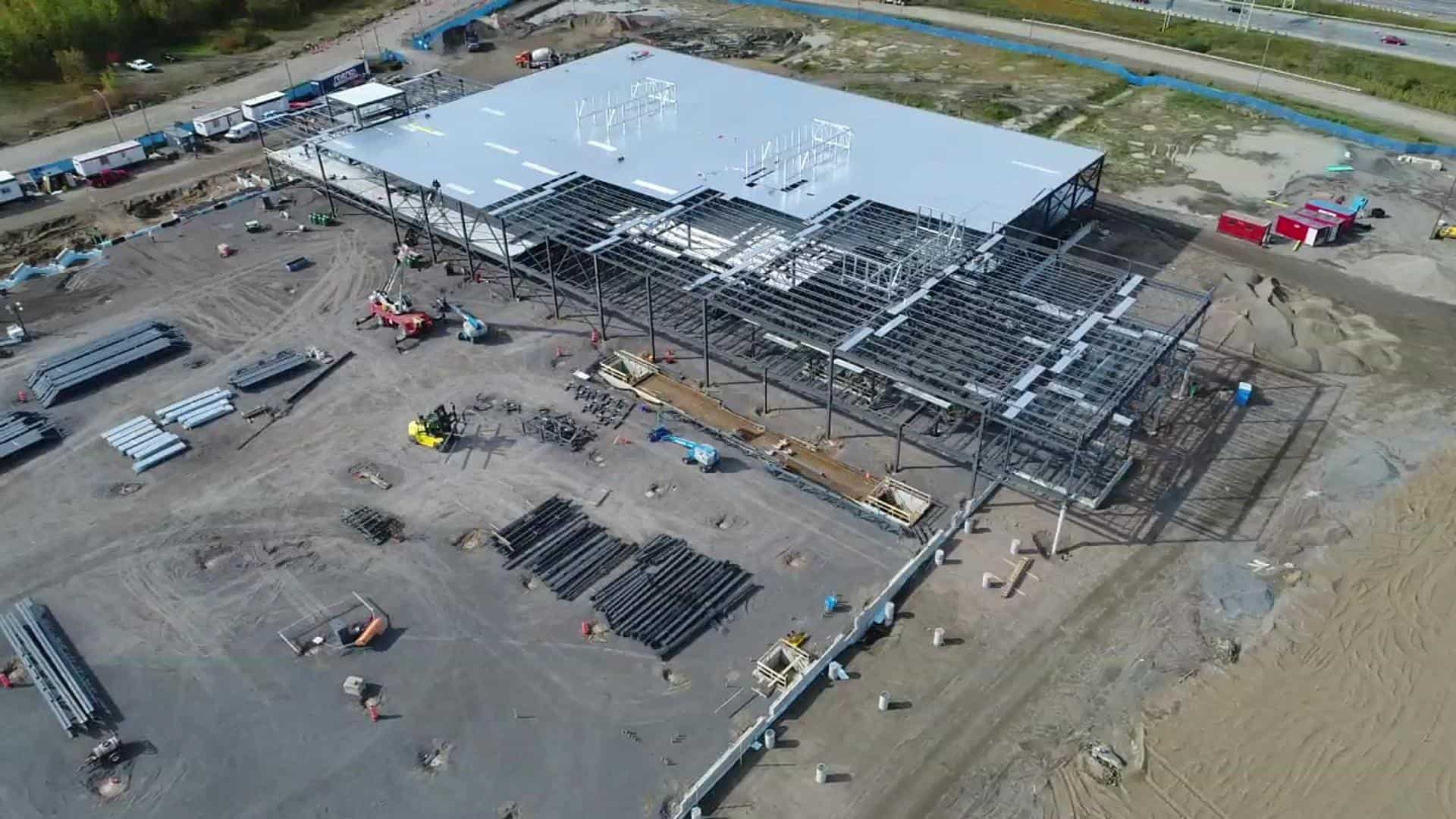Intro To Erecting Steel
There is no doubt Steel Erection is an art. Professional Erectors make erecting steel look easy.
In many cases, it is simply a matter of experience and intuition, both of which help guide erectors in determining proper sequencing and special measures to ensure the steel remains stable throughout the erection process.
Every individual working in the steel industry must take responsibility for safe work practices, regardless of job title. It is not good enough to assume that safety is someone else’s responsibility. Safety is everyone’s responsibility.
Here are items that need to be taken into consideration and followed when erecting steel each item is considered Steel Erection Best Practice’s
Structural Stability
- Ensure that structural stability is maintained at all times.
- Construction loads must not be placed on any structural steel unless such framework is safely bolted, welded, or otherwise adequately secured.
- When used, temporary bracing must be in place and properly installed in conjunction with the steel erection plan to ensure the stability of the structure.
- Temporary bracing can be removed only with the approval of a competent person.
Walking/Working Surfaces
- Avoid the use of shear connectors, where possible, that could create tripping hazards.
Slip Resistance On Skeletal Steel Structures
- Workers should avoid, where possible, walking on the top surface of any coated structural steel member that is slipperier than normal primed steel.
Connections
- During the final placing of solid web structural members, the load should not be released from the hoisting line until the member is secured with at least two bolts per connection, wrench tight. Secondary member must have one bolt wrench tight.
- A competent person must determine whether more than two bolts are required to ensure stability of a connection.
- Avoid the use of connections, where possible, to the top flanges of beams, joists, or beam attachments in which they project vertically from or horizontally across the top flange.
- During erection, diagonal bracing must be secured by at least one bolt per connection, wrench tight, before releasing load.
- If a seat or equivalent device is used, it must be sized to support the weight of the construction process.
- Where two beams, framing from opposite sides of a supporting member, share the same bolts, a clipped connection should be used unless a seated connection is used to facilitate safe erection.
Bolting and Torquing
- Follow the bolting instructions in the erection plan.
- Use retaining rings on impact sockets.
- Secure area below with flagging or signage where required.
- Inspect bolt bags daily for damage.
- Tie off impact wrench.
- Do not leave unsecured objects (e.g., bolt bags, tools, loose steel) at elevations.
- No more than four floors of unfinished bolting should be allowed above the uppermost finished floor.
Field Welding
- Welders must be certified, competent, and qualified to perform the work involved, and must have the appropriate Performance Qualification card for the processes and positions in use.
Anchor Bolts
- A minimum of 4 anchor bolts are important on main structural columns to ensure stability during erection, and is required in OSHA Subpart R.
- Wherever possible, the 4 bolt anchor pattern should be symmetrical.
Hoisting
- Careful consideration must be given to the ground conditions and the soil compaction in areas in which cranes are to be moved and operated.
- If work is done or equipment is operated in the area of an energized overhead power line, the employer must contact the power line operator to determine the voltage of the power line, which determines the safe approach distance. Until the power line operator verifies the voltage, the employer must maintain a safe clearance distance.
- For lattice boom cranes, assemble the boom sections precisely according to the manufacturer’s recommendations to attain the boom strength on which the capacities in the load chart are based.
- 0n cranes operating with outriggers, the beams must be extended with the pads down according to manufacturer’s recommendations. The ground should be checked periodically for settling, and the outriggers reset if necessary.
- Always use outrigger mats or pads to provide additional support for the crane.ln unstable surface conditions, cribbing may be needed, which should be tightly spaced using rigid timbers.
- Due to side loading in the boom, cranes should be level within the manufacturer’s specifications.
- When using crawler cranes, the tracks can be extended or retracted (use the appropriate chart). Ensure firm, level footing under the entire crane area.
- The crane operator must perform a visual inspection of all the crane components required to operate the crane in a safe condition.
- Ensure the load does not strike the boom or outriggers and never allow a crane boom to hit or touch any structure.
Critical Lifts
- The equipment and procedure used for every lift, including critical lifts, are part of the site-specific erection plan approved by competent person.
- A critical lift is a lift that exceeds 90% of the crane chart value, a lift that requires the use of more than one crane or derrick, or a lift in which the crane travels with a suspended load.
Rigging
Load Rating Of Slings And Other Rigging
- The maximum load rating is not the breaking strength of the piece of rigging. An employer must ensure that the load rating of the piece of rigging is appropriate (5 to 1 for all below-the-hook lifting devices; 10 to 1 for hoisting of personnel).
- The use of makeshift rigging fittings or attachments that bear a load is prohibited. Load bearing rigging components must be manufactured or designed by a professional engineer, fabricated by an appropriately qualified and competent worker, and certified by a professional engineer.
- The maximum load rating must be clearly marked on the rigging. If marking the rigging is not possible, the load rating should be available to workers on the site.
Load Rating Marking: Sling Standard
- Slings must meet the requirements of ASME Standard 830.9-1996, Slings. The standard describes technical requirements for construction, load rating, proof testing, identification, maintenance, environmental effects, end attachments, inspection, repair, and use.
Rejection Of Slings
- Slings must be checked before each use by workers.
- Damaged slings must be permanently removed from service.
Multiple Lift Rigging
- Rigging components must be designed with a 5 to 1 safety factor.
- Special consideration should be given to the method of rigging steel with finished surfaces in order to avoid slipping.
- A total load must not exceed the rated capacity of the hoisting or rigging equipment.
Rigging assembly must be rigged:
- – With the members attached at their center of gravity and kept in a safe level position.
- – From the top down.
- – At least 7 feet apart.
Steel Estimating Solutions
Vince Hughes
505-249-2390
PS… If you are looking to take your estimating process into the 21st century, Steel Estimating Solutions can be a great resource to help you make that happen. I have been doing digital takeoffs since 2001 and have developed a pricing tool (actually much more than that) called the Steel Erection Bid Wizard. I have helped over 260 Steel Erectors to make the transition and would love to help you as well. Give me a call anytime.
Steel Erection Bid Wizard
Join dozens of your peers that have revolutionized the way they estimate. Take your estimating department digital with Steel Erection Bid Wizard. Only software on the market made for Erectors by an Erector.
Steel Erection Bid Wizard is a fully functional Windows – based software package. Estimate your bids more quickly and easier than ever before.
Benefits of The Steel Erection Bid Wizard
- Reduce the time it takes to estimate by 50% or more
- Tried & true production rates for labor, crane & weld time
- You can easily adjust production rates to fit your company
- More than 300 built-in tasks
- Ability to create your own tasks and add new categories
- Generate one-touch proposals
- Integrate with multiple takeoff software’s
- Peace of mind

